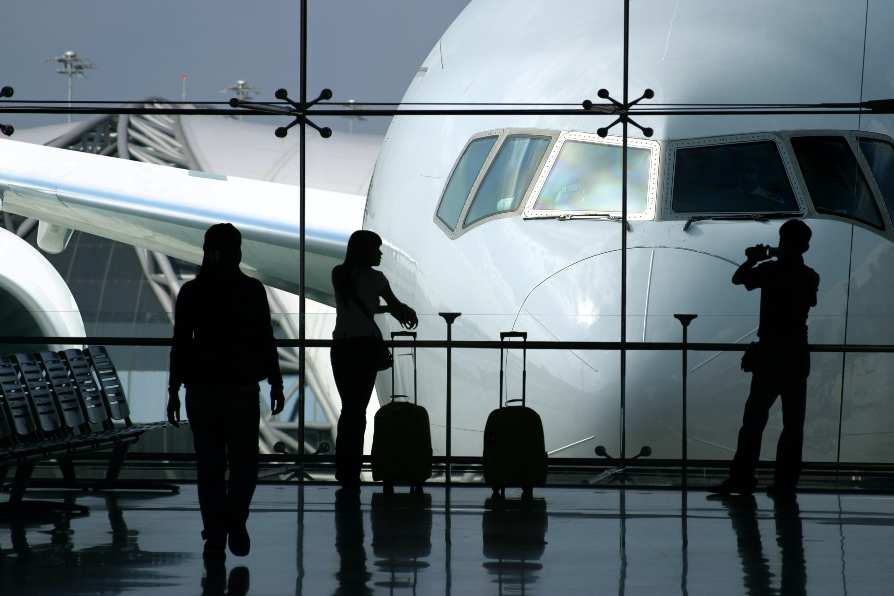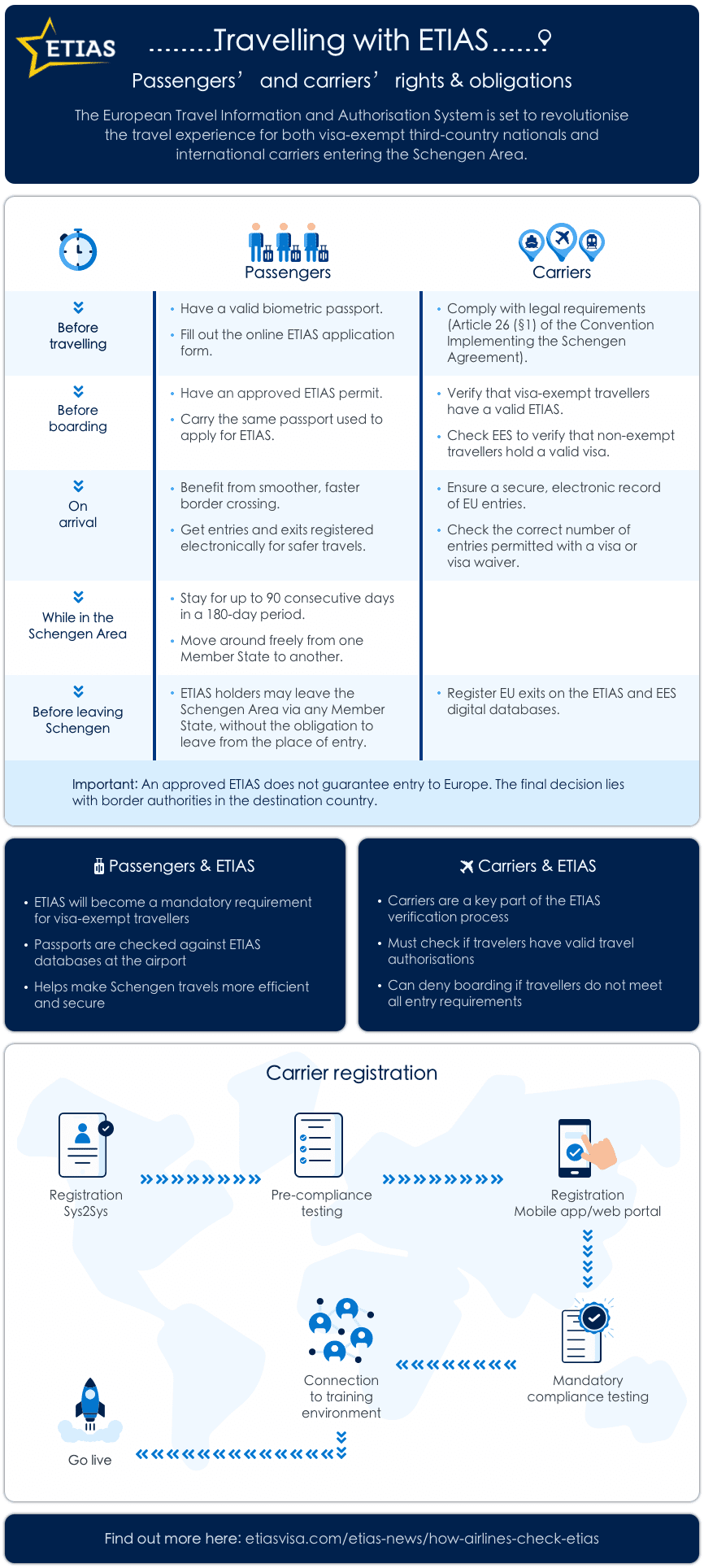
- ETIAS will make EU travel experiences easier and safer for visa-exempt third-country citizens.
- Air, land and sea carriers will be a crucial part of ETIAS implementation. Keep reading to learn more.
Third-country nationals (TCN) will soon need ETIAS, the European Travel Information and Authorisation System, to visit Europe.
From 2026 , non-EU citizens travelling without a visa will need to apply online for travel authorisation before departure.
The ETIAS travel authorisation will be checked by carriers: airlines, sea carriers and international carriers transporting groups overland by coach.
On this page, travellers can find out when ETIAS will be checked by carriers and how it will affect future trips to Europe.

CARRIERS WILL QUERY ETIAS AND EES
EU law - Regulation 2021/1217 and 2021/1224 - states that carriers (airlines, sea carriers and coaches) must query the EES and ETIAS systems before boarding.
International carriers will be obliged to query EES and ETIAS. Coaches will not be obliged to carry out ETIAS checks for the first 3 years.
Eu-LISA spokesperson Livia Vosman explained to EtiasVisa.com reporters that “As the Schengen Area has no internal border controls, carriers must be part of the verification process”.
”Due to the abolishment of the internal border controls in the Schengen area, the carriers have been mandated to ensure the application of the EES and ETIAS Regulations.”
INTERNATIONAL CARRIERS AND THE ENTRY/EXIT SYSTEM
The Entry/Exit System (EES) concerns both visa-exempt and visa-required third-country nationals.
EES replaces manual stamping, it is an electronic record of a passenger’s EU entries and exits. Rather than opening up a passport to look for a visa, carriers will carry out a digital check using the carrier interface before boarding. Although the system is new, the verification requirements are the same.
Carriers will check that a third-country national travelling with a short-stay, single or double entry visa has not already used the number of entries permitted with their visa.
INTERNATIONAL CARRIERS AND ETIAS
While the EES applies to visa-required and visa-exempt TCN, ETIAS only applies to visa-exempt TCN.
From 2026 , air and sea transport providers carrying travellers to the Schengen Area will be obliged to query ETIAS. The obligation will be extended to coaches in 2026.
Carriers will need to verify that all visa-exempt passengers have a valid ETIAS travel authorisation before boarding.
WHEN WILL EES / ETIAS BE CHECKED BY CARRIERS?
As there are no internal borders in the Schengen Area, the carrier is obliged to carry out the relevant checks before boarding. Verification can be carried out up to 48 hours before departure according to current regulations.
This is a legal requirement according to Article 26 of the Convention implementing the Schengen Agreement: “The carrier shall be obliged to take all the necessary measures to ensure that an alien carried by air or sea is in possession of the travel documents required for entry into the territories of the Contracting Parties.”
3-STEP EES AND ETIAS VERIFICATION PROCESS FOR CARRIERS
Carriers will verify whether travellers with a short-stay visa (for 1 or 2 entries) have already used the number of entries permitted. They will also check whether a visa-exempt passenger holds the required ETIAS travel authorisation.
The query for EES and ETIAS will be submitted through the carrier interface. This will be a 3-step process:
- Carrier enters passenger data into the carrier interface (web or mobile).
- Confirmation of EES/ETIAS status (2 seconds for 1 passenger, 4 seconds for up to 99 passengers).
- Carrier allows or denies boarding.
HOW WILL CARRIERS ACCESS THE EES/ETIAS CARRIER INTERFACE?
Carriers need to register to get access to the carrier interface. The carrier interface can be accessed through:
- System-to-system interface
- Web interface (available through a public website)
- Application for mobile devices
RESPONSE TO CARRIER PASSENGER QUERIES
When carriers submit a query, the answer will be:
- OK
- Not OK - EES
- Not OK - ETIAS
- Not OK - VIS
The response time will be 2 seconds for 1 passenger, and 4 seconds for up to 99 passengers.
Carriers may only board passengers who receive an OK to travel to the Schengen Area response.
WHAT HAPPENS IF A PASSENGER IS DENIED ENTRY AT THE AIRPORT?
If a passenger is denied entry at the border, there are 2 possible scenarios:
- The carrier allowed a passenger to board without confirmed OK status.
- The passenger had confirmed OK status, but was still refused entry.
The carrier will be held responsible in scenario 1. If a carrier boards a passenger without OK to travel status, they will be responsible for transporting the passenger back to the departure point. Penalties may also apply to the carrier.
In scenario 2 there will be no penalties for the carrier given that they fulfilled their obligations to query EES and /or ETIAS. They may, however, need to take the traveller back.
ETIAS does not guarantee entry to Europe. The final decision lies with border authorities in the destination country.
ETIAS, EES, AND THE PASSENGER EXPERIENCE
According to Livia Vosman, the eu-LISA spokesperson interviewed by EtiasVisa.com reporters, “border crossing for third-country nationals will be smoother and faster” following the implementation of EES and ETIAS.
The digitalisation of borders will make the management of Schengen Area borders more efficient and secure. This means that ETIAS will benefit travellers and airlines.
EES WILL MAKE BORDER CROSSING SMOOTHER AND FASTER
Instead of getting their passport stamped manually, TCN entries and exits will be registered in an electronic database.
This means passengers will be able to use self-service kiosks at airports. This should be faster than checks currently done by border guards at the counter.
ETIAS WILL MAKE EUROPEAN DESTINATIONS SAFER FOR TRAVELLERS
Passengers will complete the online ETIAS application form with basic information about their identity and passport. They will also need to answer some background questions. This information will be automatically checked against EU security databases.
Livia Vosman also told EtiasVisa.com reporters how this will benefit travellers: “ETIAS will significantly contribute to closing existing security information gaps. It will help Member States' authorities to spot earlier any individuals that may pose risks to internal security, as well as to take action before the individuals reach Schengen's external borders.”
Provided there are no hits, travel authorisation will be granted in minutes. ETIAS will be valid for up to 3 years and holders will be able to travel freely across the Schengen Area.
EES AND ETIAS REGISTRATION FOR CARRIERS
Carrier registration for EES and ETIAS began in September 2021 and became mandatory in January/February 2022.
Carriers need to register to get access to the technical documentation and tools needed to prepare their systems for EES and ETIAS.
Q&A sessions are currently being held every two weeks by eu-LISA to address carriers' questions related to the implementation of ETIAS and EES.
Dedicated eu-LISA teams will provide guidance and assistance during the testing phase. More information will be provided during an upcoming communication campaign.

